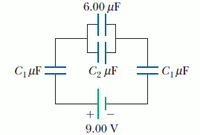
College Physics
11th Edition
ISBN: 9781305952300
Author: Raymond A. Serway, Chris Vuille
Publisher: Cengage Learning
expand_more
expand_more
format_list_bulleted
Concept explainers
Question
thumb_up100%
Find the following. (In the figure, use C1 = 10.00 μF and C2 = 5.00 μF.)
(a) the equivalent capacitance of the capacitors in the figure above
______μF
(b) the charge on each capacitor
on the right 10.00 μF capacitor _____μC
on the left 10.00 μF capacitor _____μC
on the 5.00 μF capacitor ______μC
on the 6.00 μF capacitor ______μC
(c) the potential difference across each capacitor
on the right 10.00 μF capacitor _____V
on the left 10.00 μF capacitor _____V
on the 5.00 μF capacitor ______V
on the 6.00 μF capacitor ______V

Transcribed Image Text:The diagram shown is a circuit featuring capacitors in various configurations. The circuit consists of four capacitors and a voltage source.
**Detailed Explanation:**
1. **Capacitors:**
- There are three main capacitors, labeled as \(C_1\), \(C_1\), and \(C_2\).
- The two \(C_1\) capacitors are each labeled as \(1 \, \mu \text{F}\).
- The capacitor \(C_2\) has a capacitance of \(6.00 \, \mu \text{F}\).
2. **Arrangement:**
- The \(6.00 \, \mu \text{F}\) capacitor (\(C_2\)) is in series with a combination of the two \(1 \, \mu \text{F}\) capacitors (\(C_1\)).
- These two \(1 \, \mu \text{F}\) capacitors are placed in parallel with each other.
3. **Voltage Source:**
- The power source provides a potential difference (voltage) across the circuit of \(9.00 \, \text{V}\).
- The positive and negative terminals of the voltage source are indicated, showing the direction of current flow when the circuit is complete.
This configuration is useful for understanding series and parallel capacitor arrangements and their impact on the overall capacitance and function within electric circuits.
Expert Solution
This question has been solved!
Explore an expertly crafted, step-by-step solution for a thorough understanding of key concepts.
This is a popular solution
Trending nowThis is a popular solution!
Step by stepSolved in 2 steps with 1 images

Knowledge Booster
Learn more about
Need a deep-dive on the concept behind this application? Look no further. Learn more about this topic, physics and related others by exploring similar questions and additional content below.Similar questions
- When connected in series, two capacitors have an equivalent capacitance of 1.60 µF. The same two capacitors have an equivalent capacitance of 14.0 µF when connected in parallel. What is the capacitance of each of the capacitors?arrow_forwardItem 15 Now we will consider some slightly different related scenarios to Example 21-18. Part A Example 21-18 depicts the following scenario. A circuit consists of a resistor R₁ = 126-, a resistor R₂ = 275-, a capacitor C = 182-μF, a switch, and an € = 3.00-V battery all connected in series. Initially the capacitor is uncharged and the switch is open. At time t=0 the switch is closed. increase decrease stay the same 3.00 V Suppose the resistance of the 126-2 resistor is reduced by a factor of 2. Assume everything else in the problem remains the same. Does the final value of the charge on the capacitor increase, decrease, or stay the same? Submit Request Answer ww 126 Ω 182 μF HH 275 Ω < 15 of 15 Reviewarrow_forwardPlease Asaparrow_forward
- Two capacitors give an equivalent capacitance of 10.49 pF when connected in parallel and an equivalent capacitance of 1.69 pF when connected in series. What is the capacitance in pF of the capacitor with the larger capacitance? Round your answer to 2 decimal places.arrow_forwardThree identical capacitors of 3.1 x 10-6F are used to build a circuit. Two of the capacitors are placed in parallel. The third is connected in series with the parallel capacitors. What is the equivalent capacitance of the circuit?arrow_forwardTwo capacitors give an equivalent capacitance of 10.76 pF when connected in parallel and an equivalent capacitance of 1.78 pF when connected in series. What is the capacitance in pF of the capacitor with the larger capacitance? Round your answer to 2 decimal places.arrow_forward
- Find the equivalent capacitance ?eqCeq of the combination of capacitors shown in the figure, where C1=0.825 μF , C2=10.0 μF , and C3=3.75 μF .arrow_forwardFind the equivalent capacitance of the group of capacitors shown in the figure below. (Let C, = 4.50 µF, C, = 3.80 µF, C3 = 2.80 µF, C, = 2.40 µF, C, = 2.80 µF, C6 = 6.70 µF, C, = 5.60 µF.) %3D |C| C3 |C. |C; C, Co + 48.0 V µFarrow_forward
arrow_back_ios
arrow_forward_ios
Recommended textbooks for you
 College PhysicsPhysicsISBN:9781305952300Author:Raymond A. Serway, Chris VuillePublisher:Cengage Learning
College PhysicsPhysicsISBN:9781305952300Author:Raymond A. Serway, Chris VuillePublisher:Cengage Learning University Physics (14th Edition)PhysicsISBN:9780133969290Author:Hugh D. Young, Roger A. FreedmanPublisher:PEARSON
University Physics (14th Edition)PhysicsISBN:9780133969290Author:Hugh D. Young, Roger A. FreedmanPublisher:PEARSON Introduction To Quantum MechanicsPhysicsISBN:9781107189638Author:Griffiths, David J., Schroeter, Darrell F.Publisher:Cambridge University Press
Introduction To Quantum MechanicsPhysicsISBN:9781107189638Author:Griffiths, David J., Schroeter, Darrell F.Publisher:Cambridge University Press Physics for Scientists and EngineersPhysicsISBN:9781337553278Author:Raymond A. Serway, John W. JewettPublisher:Cengage Learning
Physics for Scientists and EngineersPhysicsISBN:9781337553278Author:Raymond A. Serway, John W. JewettPublisher:Cengage Learning Lecture- Tutorials for Introductory AstronomyPhysicsISBN:9780321820464Author:Edward E. Prather, Tim P. Slater, Jeff P. Adams, Gina BrissendenPublisher:Addison-Wesley
Lecture- Tutorials for Introductory AstronomyPhysicsISBN:9780321820464Author:Edward E. Prather, Tim P. Slater, Jeff P. Adams, Gina BrissendenPublisher:Addison-Wesley College Physics: A Strategic Approach (4th Editio...PhysicsISBN:9780134609034Author:Randall D. Knight (Professor Emeritus), Brian Jones, Stuart FieldPublisher:PEARSON
College Physics: A Strategic Approach (4th Editio...PhysicsISBN:9780134609034Author:Randall D. Knight (Professor Emeritus), Brian Jones, Stuart FieldPublisher:PEARSON

College Physics
Physics
ISBN:9781305952300
Author:Raymond A. Serway, Chris Vuille
Publisher:Cengage Learning

University Physics (14th Edition)
Physics
ISBN:9780133969290
Author:Hugh D. Young, Roger A. Freedman
Publisher:PEARSON

Introduction To Quantum Mechanics
Physics
ISBN:9781107189638
Author:Griffiths, David J., Schroeter, Darrell F.
Publisher:Cambridge University Press

Physics for Scientists and Engineers
Physics
ISBN:9781337553278
Author:Raymond A. Serway, John W. Jewett
Publisher:Cengage Learning

Lecture- Tutorials for Introductory Astronomy
Physics
ISBN:9780321820464
Author:Edward E. Prather, Tim P. Slater, Jeff P. Adams, Gina Brissenden
Publisher:Addison-Wesley

College Physics: A Strategic Approach (4th Editio...
Physics
ISBN:9780134609034
Author:Randall D. Knight (Professor Emeritus), Brian Jones, Stuart Field
Publisher:PEARSON